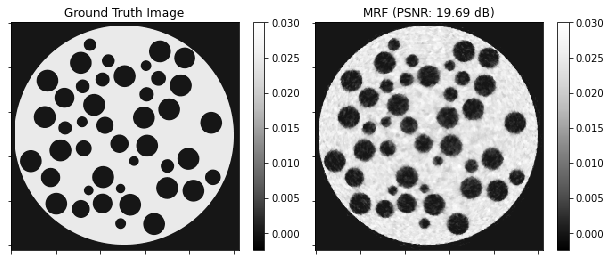TV-Regularized CT Reconstruction (Multiple Algorithms)#
This example demonstrates the use of different optimization algorithms to solve the TV-regularized CT problem
\[\mathrm{argmin}_{\mathbf{x}} \; (1/2) \| \mathbf{y} - A \mathbf{x}
\|_2^2 + \lambda \| C \mathbf{x} \|_{2,1} \;,\]
where \(A\) is the X-ray transform (implemented using the SVMBIR [48] tomographic projection), \(\mathbf{y}\) is the sinogram, \(C\) is a 2D finite difference operator, and \(\mathbf{x}\) is the desired image.
[1]:
import numpy as np
import matplotlib.pyplot as plt
import svmbir
from xdesign import Foam, discrete_phantom
import scico.numpy as snp
from scico import functional, linop, metric, plot
from scico.linop import Diagonal
from scico.linop.xray.svmbir import SVMBIRSquaredL2Loss, XRayTransform
from scico.optimize import PDHG, LinearizedADMM
from scico.optimize.admm import ADMM, LinearSubproblemSolver
from scico.util import device_info
plot.config_notebook_plotting()
Generate a ground truth image.
[2]:
N = 256 # image size
density = 0.025 # attenuation density of the image
np.random.seed(1234)
x_gt = discrete_phantom(Foam(size_range=[0.05, 0.02], gap=0.02, porosity=0.3), size=N - 10)
x_gt = x_gt / np.max(x_gt) * density
x_gt = np.pad(x_gt, 5)
x_gt[x_gt < 0] = 0
Generate tomographic projector and sinogram.
[3]:
num_angles = int(N / 2)
num_channels = N
angles = snp.linspace(0, snp.pi, num_angles, dtype=snp.float32)
A = XRayTransform(x_gt.shape, angles, num_channels)
sino = A @ x_gt
Impose Poisson noise on sinogram. Higher max_intensity means less noise.
[4]:
max_intensity = 2000
expected_counts = max_intensity * np.exp(-sino)
noisy_counts = np.random.poisson(expected_counts).astype(np.float32)
noisy_counts[noisy_counts == 0] = 1 # deal with 0s
y = -snp.log(noisy_counts / max_intensity)
Reconstruct using default prior of SVMBIR [48].
[5]:
weights = svmbir.calc_weights(y, weight_type="transmission")
x_mrf = svmbir.recon(
np.array(y[:, np.newaxis]),
np.array(angles),
weights=weights[:, np.newaxis],
num_rows=N,
num_cols=N,
positivity=True,
verbose=0,
)[0]
Set up problem.
[6]:
x0 = snp.array(x_mrf)
weights = snp.array(weights)
λ = 1e-1 # ℓ1 norm regularization parameter
f = SVMBIRSquaredL2Loss(y=y, A=A, W=Diagonal(weights), scale=0.5)
g = λ * functional.L21Norm() # regularization functional
# The append=0 option makes the results of horizontal and vertical finite
# differences the same shape, which is required for the L21Norm.
C = linop.FiniteDifference(input_shape=x_gt.shape, append=0)
Solve via ADMM.
[7]:
solve_admm = ADMM(
f=f,
g_list=[g],
C_list=[C],
rho_list=[2e1],
x0=x0,
maxiter=50,
subproblem_solver=LinearSubproblemSolver(cg_kwargs={"tol": 1e-4, "maxiter": 10}),
itstat_options={"display": True, "period": 10},
)
print(f"Solving on {device_info()}\n")
x_admm = solve_admm.solve()
hist_admm = solve_admm.itstat_object.history(transpose=True)
print(f"PSNR: {metric.psnr(x_gt, x_admm):.2f} dB\n")
Solving on GPU (NVIDIA GeForce RTX 2080 Ti)
Iter Time Objective Prml Rsdl Dual Rsdl CG It CG Res
-----------------------------------------------------------------
0 7.67e+00 8.928e+00 6.583e-01 5.653e-01 10 1.180e-03
10 6.74e+01 1.604e+01 2.446e-02 3.015e-02 8 8.752e-05
20 1.00e+02 1.615e+01 1.256e-02 1.155e-02 4 9.080e-05
30 1.27e+02 1.619e+01 7.830e-03 7.858e-03 4 8.817e-05
40 1.45e+02 1.622e+01 6.360e-03 6.734e-04 0 9.262e-05
49 1.59e+02 1.622e+01 4.806e-03 4.874e-04 0 9.458e-05
PSNR: 22.93 dB
Solve via Linearized ADMM.
[8]:
solver_ladmm = LinearizedADMM(
f=f,
g=g,
C=C,
mu=3e-2,
nu=2e-1,
x0=x0,
maxiter=50,
itstat_options={"display": True, "period": 10},
)
x_ladmm = solver_ladmm.solve()
hist_ladmm = solver_ladmm.itstat_object.history(transpose=True)
print(f"PSNR: {metric.psnr(x_gt, x_ladmm):.2f} dB\n")
Iter Time Objective Prml Rsdl Dual Rsdl
-----------------------------------------------
0 1.31e+00 5.302e+00 1.071e+00 1.100e+00
10 8.96e+00 1.538e+01 1.336e-01 5.319e-02
20 1.64e+01 1.580e+01 5.625e-02 2.221e-02
30 2.31e+01 1.594e+01 3.318e-02 1.151e-02
40 2.90e+01 1.601e+01 2.365e-02 6.898e-03
49 3.41e+01 1.606e+01 1.878e-02 4.803e-03
PSNR: 22.86 dB
Solve via PDHG.
[9]:
solver_pdhg = PDHG(
f=f,
g=g,
C=C,
tau=2e-2,
sigma=8e0,
x0=x0,
maxiter=50,
itstat_options={"display": True, "period": 10},
)
x_pdhg = solver_pdhg.solve()
hist_pdhg = solver_pdhg.itstat_object.history(transpose=True)
print(f"PSNR: {metric.psnr(x_gt, x_pdhg):.2f} dB\n")
Iter Time Objective Prml Rsdl Dual Rsdl
-----------------------------------------------
0 6.37e-01 2.244e+01 7.208e+00 1.056e+00
10 7.34e+00 1.753e+01 1.777e+00 9.542e-02
20 1.37e+01 1.676e+01 6.840e-01 4.022e-02
30 2.02e+01 1.650e+01 2.999e-01 2.202e-02
40 2.71e+01 1.640e+01 1.495e-01 1.490e-02
49 3.28e+01 1.636e+01 9.505e-02 1.154e-02
PSNR: 22.92 dB
Show the recovered images.
[10]:
norm = plot.matplotlib.colors.Normalize(vmin=-0.1 * density, vmax=1.2 * density)
fig, ax = plt.subplots(1, 2, figsize=[10, 5])
plot.imview(img=x_gt, title="Ground Truth Image", cbar=True, fig=fig, ax=ax[0], norm=norm)
plot.imview(
img=x_mrf,
title=f"MRF (PSNR: {metric.psnr(x_gt, x_mrf):.2f} dB)",
cbar=True,
fig=fig,
ax=ax[1],
norm=norm,
)
fig.show()
fig, ax = plt.subplots(1, 3, figsize=[15, 5])
plot.imview(
img=x_admm,
title=f"TV ADMM (PSNR: {metric.psnr(x_gt, x_admm):.2f} dB)",
cbar=True,
fig=fig,
ax=ax[0],
norm=norm,
)
plot.imview(
img=x_ladmm,
title=f"TV LinADMM (PSNR: {metric.psnr(x_gt, x_ladmm):.2f} dB)",
cbar=True,
fig=fig,
ax=ax[1],
norm=norm,
)
plot.imview(
img=x_pdhg,
title=f"TV PDHG (PSNR: {metric.psnr(x_gt, x_pdhg):.2f} dB)",
cbar=True,
fig=fig,
ax=ax[2],
norm=norm,
)
fig.show()


Plot convergence statistics.
[11]:
fig, ax = plot.subplots(nrows=1, ncols=3, sharex=True, sharey=False, figsize=(27, 6))
plot.plot(
snp.vstack((hist_admm.Objective, hist_ladmm.Objective, hist_pdhg.Objective)).T,
ptyp="semilogy",
title="Objective function",
xlbl="Iteration",
lgnd=("ADMM", "LinADMM", "PDHG"),
fig=fig,
ax=ax[0],
)
plot.plot(
snp.vstack((hist_admm.Prml_Rsdl, hist_ladmm.Prml_Rsdl, hist_pdhg.Prml_Rsdl)).T,
ptyp="semilogy",
title="Primal residual",
xlbl="Iteration",
lgnd=("ADMM", "LinADMM", "PDHG"),
fig=fig,
ax=ax[1],
)
plot.plot(
snp.vstack((hist_admm.Dual_Rsdl, hist_ladmm.Dual_Rsdl, hist_pdhg.Dual_Rsdl)).T,
ptyp="semilogy",
title="Dual residual",
xlbl="Iteration",
lgnd=("ADMM", "LinADMM", "PDHG"),
fig=fig,
ax=ax[2],
)
fig.show()
fig, ax = plot.subplots(nrows=1, ncols=3, sharex=True, sharey=False, figsize=(27, 6))
plot.plot(
snp.vstack((hist_admm.Objective, hist_ladmm.Objective, hist_pdhg.Objective)).T,
snp.vstack((hist_admm.Time, hist_ladmm.Time, hist_pdhg.Time)).T,
ptyp="semilogy",
title="Objective function",
xlbl="Time (s)",
lgnd=("ADMM", "LinADMM", "PDHG"),
fig=fig,
ax=ax[0],
)
plot.plot(
snp.vstack((hist_admm.Prml_Rsdl, hist_ladmm.Prml_Rsdl, hist_pdhg.Prml_Rsdl)).T,
snp.vstack((hist_admm.Time, hist_ladmm.Time, hist_pdhg.Time)).T,
ptyp="semilogy",
title="Primal residual",
xlbl="Time (s)",
lgnd=("ADMM", "LinADMM", "PDHG"),
fig=fig,
ax=ax[1],
)
plot.plot(
snp.vstack((hist_admm.Dual_Rsdl, hist_ladmm.Dual_Rsdl, hist_pdhg.Dual_Rsdl)).T,
snp.vstack((hist_admm.Time, hist_ladmm.Time, hist_pdhg.Time)).T,
ptyp="semilogy",
title="Dual residual",
xlbl="Time (s)",
lgnd=("ADMM", "LinADMM", "PDHG"),
fig=fig,
ax=ax[2],
)
fig.show()

